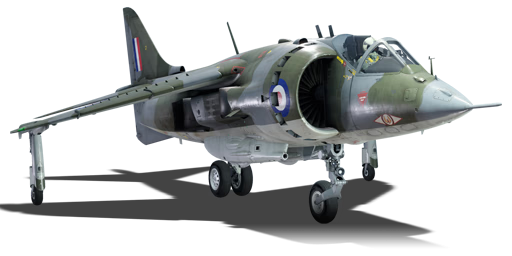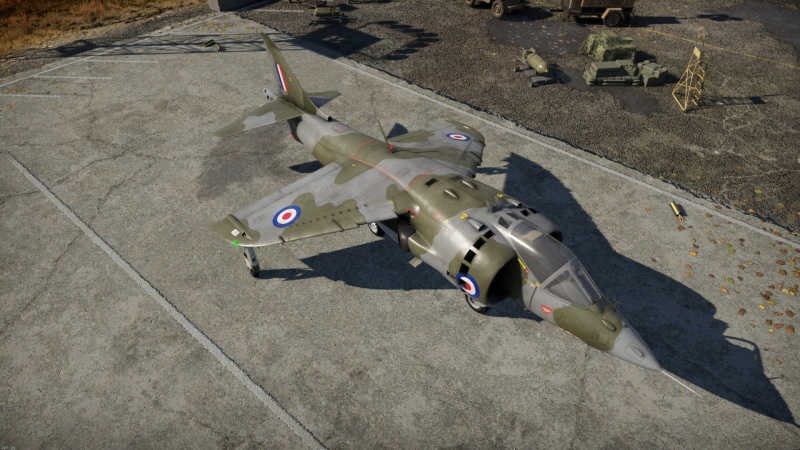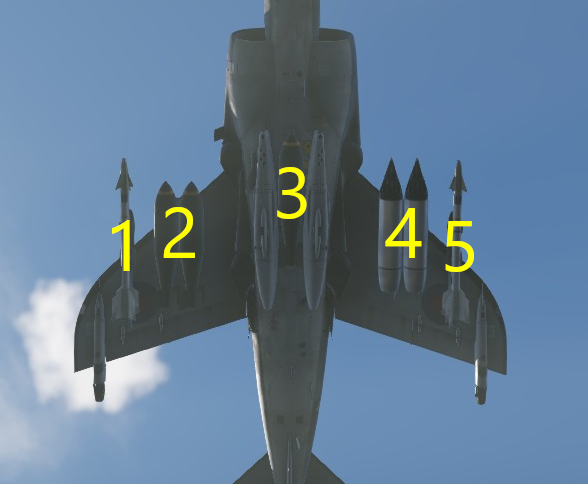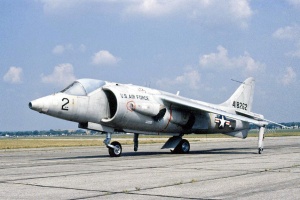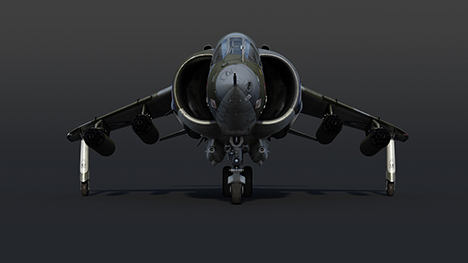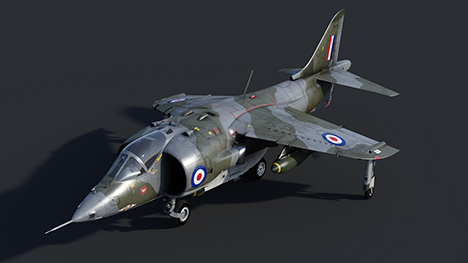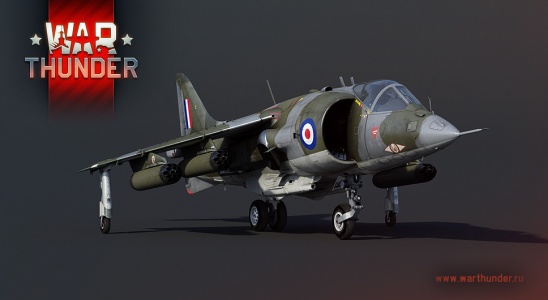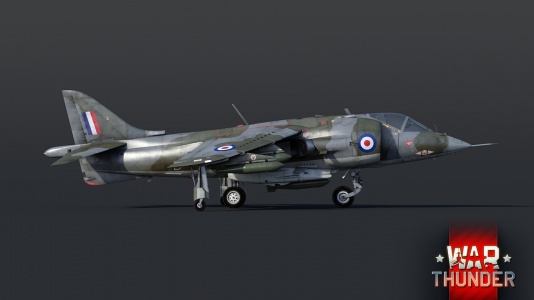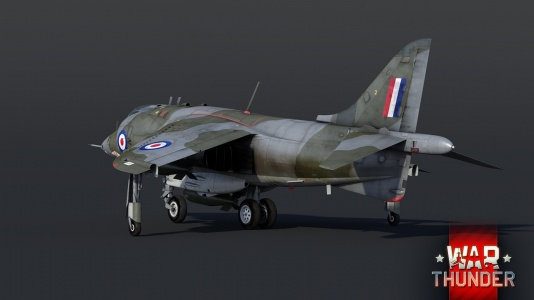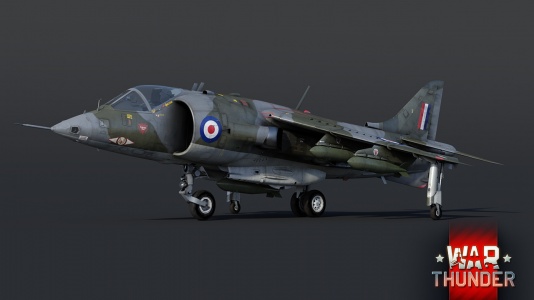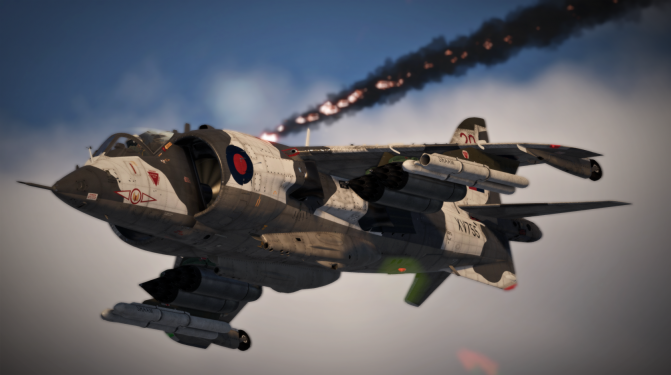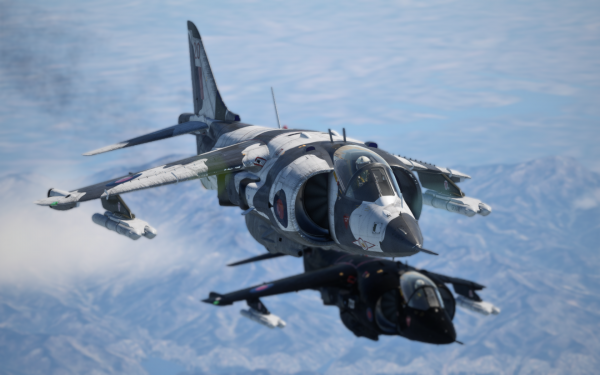Difference between revisions of "Harrier GR.1"
CobraKingII (talk | contribs) (→Media) (Tag: Visual edit) |
m (→Pros and cons: typo) (Tag: Visual edit) |
||
| (53 intermediate revisions by 20 users not shown) | |||
| Line 1: | Line 1: | ||
| − | |||
{{About | {{About | ||
| − | | about = British | + | | about = premium British strike aircraft '''{{PAGENAME}}''' |
| usage = other versions | | usage = other versions | ||
| link = Harrier (Family) | | link = Harrier (Family) | ||
| + | }} | ||
| + | {{Specs-Card | ||
| + | |code=harrier_gr1 | ||
| + | |images={{Specs-Card-Image|GarageImage_{{PAGENAME}}.jpg}} | ||
}} | }} | ||
== Description == | == Description == | ||
<!-- ''In the description, the first part should be about the history of and the creation and combat usage of the aircraft, as well as its key features. In the second part, tell the reader about the aircraft in the game. Insert a screenshot of the vehicle, so that if the novice player does not remember the vehicle by name, he will immediately understand what kind of vehicle the article is talking about.'' --> | <!-- ''In the description, the first part should be about the history of and the creation and combat usage of the aircraft, as well as its key features. In the second part, tell the reader about the aircraft in the game. Insert a screenshot of the vehicle, so that if the novice player does not remember the vehicle by name, he will immediately understand what kind of vehicle the article is talking about.'' --> | ||
| − | + | The '''{{Specs|name}}''' was developed from the Hawker-Siddeley P.1127 and the Hawker-Siddeley Kestrel FGA.1 prototype aircraft that demonstrated the feasibility of using vectored thrust to achieve V/STOL capability. Recognizing the potential of this technology to operate from unprepared sites and evade enemy air defenses, the Royal Air Force (RAF) adopted it for their use. In 1969, the {{Specs|name}} was officially introduced into service. It was primarily designed for ground-attack and reconnaissance missions, capitalizing on its unique ability to take off and land in a variety of environments. This flexibility made it a valuable asset in the RAF's arsenal. Beyond its primary roles, the {{Specs|name}} was also tested with Short Range Air-to-Air Missiles (SRAAMs), a British project that spanned from 1968 to 1980. These infrared homing missiles were capable of executing high-G turns, making them ideal for close-range dogfights. It paved the way for future advancements in aircraft design and missile technology, setting the stage for the next generation of combat aircraft and air-to-air missiles. | |
| − | + | ||
| − | + | The {{Specs|name}} was introduced in [[Update "New Power"]]. Like all members of the [[Harrier (Family)|Harrier family]], the Harrier GR.1 is a [[VTOL]] aircraft with thrust vectoring nozzles, which allow it to take off and land vertically. The Harrier GR.1 can be equipped with a variety of ordnance, including SRAAMs, bombs, and rockets. It excels at low-altitude combat, where it can use its VTOL capabilities to surprise enemies and evade attacks. However, it also has low top speed and agility, making it easy prey for faster and more manoeuvrable enemies. Additionally, it lacks any kind of countermeasures, such as chaff or flares, leaving it vulnerable to enemy missile attacks. On the bright side, the aircraft can use its SRAAMs to intercept incoming missiles head-on. It is a challenging but rewarding aircraft to master, offering a unique gameplay experience and a versatile loadout. | |
== General info == | == General info == | ||
=== Flight performance === | === Flight performance === | ||
| + | {{Specs-Avia-Flight}} | ||
<!-- ''Describe how the aircraft behaves in the air. Speed, manoeuvrability, acceleration and allowable loads - these are the most important characteristics of the vehicle.'' --> | <!-- ''Describe how the aircraft behaves in the air. Speed, manoeuvrability, acceleration and allowable loads - these are the most important characteristics of the vehicle.'' --> | ||
| + | The Harrier GR.1 has an impressive climb rate, though it is put down by Soviet jets that it may face, like the [[MiG-19PT]], [[Su-7B]], and [[Su-7BKL]]. The Harrier's climb rate also suffers the more armament it carries; even just 4 [[SRAAM]]s drops the climb rate from 80 m/s to 68.2 m/s. Equipping 4 x 1,000 lb bombs cuts the climb rate by more than half. Because the Pegasus engine loses thrust at higher altitudes, the climb rate decreases with it. | ||
| + | |||
| + | The Pegasus engine has amazing low-altitude acceleration, but continues to suffer more at higher altitudes. In the early game, the [[Harrier (Family)]] planes will usually be seen pulling ahead of planes with afterburner (From the airfield, air spawns start the planes with a higher top speed at a higher start speed), but the subsonic status makes the planes with a higher speed catch up after a bit. | ||
| + | |||
| + | The turn rate of the GR.1 is mediocre compared to other planes it may face, especially planes from the [[F-86 (Family)]] and the previously mentioned Soviet planes. The rate of turn suffers the higher it climbs, as with the climb rate. Takeoff flaps, with their very high limit, can be utilized to turn sharper, as well as using the [[VTOL]] function correctly. | ||
| + | |||
| + | '''''Controls tend to lock up at altitudes over 7,000 m (23,000 feet), because of the massive lost of thrust in the Pegasus engine.''''' | ||
{| class="wikitable" style="text-align:center" width="70%" | {| class="wikitable" style="text-align:center" width="70%" | ||
| Line 56: | Line 67: | ||
! Combat !! Take-off !! Landing !! + !! - | ! Combat !! Take-off !! Landing !! + !! - | ||
|- | |- | ||
| − | | {{Specs|destruction|body}} || {{Specs|destruction|gear}} || N/A || | + | | {{Specs|destruction|body}} || {{Specs|destruction|gear}} || N/A || 829 || 556 || ~14 || ~6 |
|- | |- | ||
|} | |} | ||
| Line 107: | Line 118: | ||
=== Survivability and armour === | === Survivability and armour === | ||
| + | {{Specs-Avia-Armour}} | ||
<!-- ''Examine the survivability of the aircraft. Note how vulnerable the structure is and how secure the pilot is, whether the fuel tanks are armoured, etc. Describe the armour, if there is any, and also mention the vulnerability of other critical aircraft systems.'' --> | <!-- ''Examine the survivability of the aircraft. Note how vulnerable the structure is and how secure the pilot is, whether the fuel tanks are armoured, etc. Describe the armour, if there is any, and also mention the vulnerability of other critical aircraft systems.'' --> | ||
| − | The Harrier GR.1 has no armour. The engine and all fuel tanks are packed in a tight cluster in the centre of the fuselage. | + | The Harrier GR.1 has no armour. The engine and all fuel tanks are packed in a tight cluster in the centre of the fuselage. However, a Harrier with critical damage, even losing both wings, can often still make it back to the airfield. This has to be done at VTOL speeds, meaning under 300 km/h, making you a big target. |
| + | |||
| + | === Modifications and economy === | ||
| + | {{Specs-Economy}} | ||
== Armaments == | == Armaments == | ||
| + | {{Specs-Avia-Armaments}} | ||
| + | {| class="wikitable" style="text-align:center" | ||
| + | |- | ||
| + | ! colspan="4" | [[Ballistic Computer]] | ||
| + | |- | ||
| + | ! CCIP (Guns) !! CCIP (Rockets) !! CCIP (Bombs) !! CCRP (Bombs) | ||
| + | |- | ||
| + | | {{Tick}} || {{Tick}} || {{Tick}} || {{Tick}} | ||
| + | |- | ||
| + | |} | ||
=== Offensive armament === | === Offensive armament === | ||
| + | {{Specs-Avia-Offensive}} | ||
<!-- ''Describe the offensive armament of the aircraft, if any. Describe how effective the cannons and machine guns are in a battle, and also what belts or drums are better to use. If there is no offensive weaponry, delete this subsection.'' --> | <!-- ''Describe the offensive armament of the aircraft, if any. Describe how effective the cannons and machine guns are in a battle, and also what belts or drums are better to use. If there is no offensive weaponry, delete this subsection.'' --> | ||
{{main|ADEN Mk.4 (30 mm)}} | {{main|ADEN Mk.4 (30 mm)}} | ||
| Line 118: | Line 144: | ||
The '''''{{PAGENAME}}''''' is armed with: | The '''''{{PAGENAME}}''''' is armed with: | ||
| − | * 2 x 30 mm ADEN Mk.4 cannons, belly-mounted ( | + | * 2 x 30 mm ADEN Mk.4 cannons, belly-mounted (130 rpg = 260 total) |
=== Suspended armament === | === Suspended armament === | ||
| + | {{Specs-Avia-Suspended}} | ||
<!-- ''Describe the aircraft's suspended armament: additional cannons under the wings, bombs, rockets and torpedoes. This section is especially important for bombers and attackers. If there is no suspended weaponry remove this subsection.'' --> | <!-- ''Describe the aircraft's suspended armament: additional cannons under the wings, bombs, rockets and torpedoes. This section is especially important for bombers and attackers. If there is no suspended weaponry remove this subsection.'' --> | ||
| − | |||
The '''''{{PAGENAME}}''''' can be outfitted with the following ordnance: | The '''''{{PAGENAME}}''''' can be outfitted with the following ordnance: | ||
| + | |||
| + | {| class="wikitable" style="text-align:center" width="100%" | ||
| + | |- | ||
| + | ! !! width="9%" | 1 !! width="9%" | 2 !! width="9%" | 3 !! width="9%" | 4 !! width="9%" | 5 | ||
| + | | rowspan="7" width="25%" | <div class="ttx-image">[[File:Hardpoints_Harrier_GR.3.png]]</div> | ||
| + | |- | ||
| + | ! [[H.E. M.C. Mk.II (500 lb)|500 lb H.E. M.C. Mk.II]] bombs | ||
| + | | 1 || 1, 2 || 1 || 1, 2 || 1 | ||
| + | |- | ||
| + | ! [[H.E. M.C. Mk.13 (1,000 lb)|1,000 lb H.E. M.C. Mk.13]] bombs | ||
| + | | || 1, 2 || 1 || 1, 2 || | ||
| + | |- | ||
| + | ! [[H.E. M.C. Mk.13 No.117 (1,000 lb)|1,000 lb H.E. M.C. Mk.13 No.117]] bombs | ||
| + | | || 1, 2 || 1 || 1, 2 || | ||
| + | |- | ||
| + | ! [[Mk 77 mod 4 incendiary]] bombs | ||
| + | | 1 || 1 || 1 || 1 || 1 | ||
| + | |- | ||
| + | ! [[SNEB type 23]] rockets | ||
| + | | 18 || 36 || || 36 || 18 | ||
| + | |- | ||
| + | ! [[SRAAM]] missiles | ||
| + | | 2 || || || || 2 | ||
| + | |- | ||
| + | |} | ||
| + | |||
| + | {{Navigation-Start|Default weapon presets}} | ||
| + | {{Navigation-First-Simple-Line}} | ||
* Without load | * Without load | ||
| + | * 4 x SRAAM missiles | ||
| + | * 108 x SNEB type 23 rockets | ||
* 5 x 500 lb H.E. M.C. Mk.II bombs (2,500 lb total) | * 5 x 500 lb H.E. M.C. Mk.II bombs (2,500 lb total) | ||
* 4 x 500 lb H.E. M.C. Mk.II bombs (2,000 lb total) | * 4 x 500 lb H.E. M.C. Mk.II bombs (2,000 lb total) | ||
| − | * 3 x 1,000 lb | + | * 3 x 1,000 lb H.E. M.C. Mk.13 bombs (3,000 lb total) |
| − | * | + | * 3 x 1,000 lb H.E. M.C. Mk.13 No.117 bombs (3,000 lb total) |
| − | + | * 4 x 1,000 lb H.E. M.C. Mk.13 bombs (4,000 lb total) | |
| − | * 4 x | + | * 4 x 1,000 lb H.E. M.C. Mk.13 No.117 bombs (4,000 lb total) |
| − | + | * 5 x Mk 77 mod 4 incendiary bombs | |
| − | * 4 | + | {{Navigation-End}} |
| − | * 4 | ||
== Usage in battles == | == Usage in battles == | ||
| Line 142: | Line 197: | ||
Despite having a weaker engine than other members of the [[Harrier (Family)|Harrier family]], the Harrier GR.1 still possesses exceptional acceleration and rate of climb. Coupled with a decent selection of load-outs (including the extremely powerful [[SRAAM]] missiles), and VTOL capability; this makes the Harrier GR.1 a very potent aircraft for both air-to-air combat and ground attack. | Despite having a weaker engine than other members of the [[Harrier (Family)|Harrier family]], the Harrier GR.1 still possesses exceptional acceleration and rate of climb. Coupled with a decent selection of load-outs (including the extremely powerful [[SRAAM]] missiles), and VTOL capability; this makes the Harrier GR.1 a very potent aircraft for both air-to-air combat and ground attack. | ||
| − | Generally a good way to start the game in the Harrier GR.1, when you are are facing aircraft around your BR or lower, is to takeoff and use your incredible | + | Generally a good way to start the game in the Harrier GR.1, when you are are facing aircraft around your BR or lower, is to takeoff and use your incredible acceleration and climb rate to get up and above the enemy aircraft. Climb slightly to the side of the battle and once you have sufficient altitude begin to swoop down on enemy aircraft below you, dispensing of them with your SRAAMs, or ADEN cannons. When climbing it is best to keep the throttle at only 90-95%, and to not use WEP; even at 90% throttle the mighty Pegasus engine is still capable of giving the Harrier a very impressive climb rate. This is advisable as the Harrier only has about 90 seconds of total WEP time, and there are better uses for it than climbing; in addition the Pegasus engine is not designed to be run a full power for extended periods of time and will overheat if left on 100% throttle for too long. As the battle goes on you can drop down to lower altitude to engage your enemies; you should generally avoid turn fighting, instead opting to make high speed attacks from the side of enemies. How much fuel you take is up to you: the minimum load of 10 minutes gives you an incredible thrust to weight ratio and can be enough for short battles, however it is not enough to last longer battles without refuelling. |
When facing enemy aircraft which are mostly above your BR (i.e. top tier jets) you need to be much more cautious when taking the climbing approach. Against top tier jets the Harrier's climb rate is less impressive, and being at high altitude leaves you vulnerable to attack from long range [[Air-to-air_missiles#Semi-Active_Radar_Homing_.28SARH.29_missiles|semi-active radar homing air-to-air missile]], an issue exacerbated by the Harrier GR.1's lack of a radar warning receiver. In such battles it is better to stay low and fast, picking off top tier jets with fast approaches from the side, or by forcing an overshoot (thrust vectoring helps with this). | When facing enemy aircraft which are mostly above your BR (i.e. top tier jets) you need to be much more cautious when taking the climbing approach. Against top tier jets the Harrier's climb rate is less impressive, and being at high altitude leaves you vulnerable to attack from long range [[Air-to-air_missiles#Semi-Active_Radar_Homing_.28SARH.29_missiles|semi-active radar homing air-to-air missile]], an issue exacerbated by the Harrier GR.1's lack of a radar warning receiver. In such battles it is better to stay low and fast, picking off top tier jets with fast approaches from the side, or by forcing an overshoot (thrust vectoring helps with this). | ||
[[File:Harrier SRAAM Kill.mp4|thumb|400px|right|Getting a side-attack kill with an SRAAM. When launched in this way the SRAAMs are extremely hard to dodge.]] | [[File:Harrier SRAAM Kill.mp4|thumb|400px|right|Getting a side-attack kill with an SRAAM. When launched in this way the SRAAMs are extremely hard to dodge.]] | ||
| − | The primary air-to-air weapon of the Harrier GR.1 are its four incredibly powerful [[SRAAM]] missiles. The SRAAMs are missiles of extremes, outside of 1.0 - 1.2 km they are near useless, however once you get to within 1.2 km of your target they transform into one of the hardest missiles in the game to dodge. The thrust vectoring nature of SRAAMs make them extremely manoeuvrable and hard to dodge, but mean the missiles cannot manoeuvre at all after the motor burns out, significantly limiting their range. To get the most out of SRAAMs you need to play to their advantages, the SRAAMs' poor range means that firing them from directly behind a target while chasing them is not the best idea unless you are very close, have a speed advantage, or the target is manoeuvring. Instead, the optimal way to use SRAAMs is to approach perpendicular to the target and attempt to obtain a lock from as far out as possible. With a lock obtained you should close on the target from the side; as you approach the 1.2 km mark you should turn into the target and "lead" the missile like you would your guns. Fire the missile within 1 km of the target and there is little they will be able to do about it; the SRAAM's extreme manoeuvrability allows them to follow the target through most evasive manoeuvres. A video of this method can be seen to the right. A key weakness of the SRAAMs (other than their limited range) is that they are highly susceptible to flares. You should either pick targets not equipped with flares, or if a target is equipped with flares try to attack when they are distracted or approach from an angle where you will hopefully not be noticed until it is too late. | + | The primary air-to-air weapon of the Harrier GR.1 are its four incredibly powerful [[SRAAM]] missiles. The SRAAMs are missiles of extremes, outside of 1.0-1.2 km they are near useless, however once you get to within 1.2 km of your target they transform into one of the hardest missiles in the game to dodge. The thrust vectoring nature of SRAAMs make them extremely manoeuvrable and hard to dodge, but mean the missiles cannot manoeuvre at all after the motor burns out, significantly limiting their range. To get the most out of SRAAMs you need to play to their advantages, the SRAAMs' poor range means that firing them from directly behind a target while chasing them is not the best idea unless you are very close, have a speed advantage, or the target is manoeuvring. Instead, the optimal way to use SRAAMs is to approach perpendicular to the target and attempt to obtain a lock from as far out as possible. With a lock obtained you should close on the target from the side; as you approach the 1.2 km mark you should turn into the target and "lead" the missile like you would your guns. Fire the missile within 1 km of the target and there is little they will be able to do about it; the SRAAM's extreme manoeuvrability allows them to follow the target through most evasive manoeuvres. A video of this method can be seen to the right. A key weakness of the SRAAMs (other than their limited range) is that they are highly susceptible to flares. You should either pick targets not equipped with flares, or if a target is equipped with flares try to attack when they are distracted or approach from an angle where you will hopefully not be noticed until it is too late. |
While the addition of SRAAMs makes the Harrier GR.1 a potent fighter, it was designed as a ground attack aircraft, and it is very capable at filling this role in-game. The Harrier GR.1 has a good selection of bombs or rockets, coupled with a [[Ballistic Computer|ballistic computer]] providing CCIP this makes the Harrier a powerful ground attacker in both air and ground battles. In air battles the two ADEN cannons are very effective at killing ground targets up to medium tanks and light pillboxes (a task made easier with the ballistic computer), and have a plentiful ammo supply. The ability to reliably kill ground targets is useful for both opportunistic attacks for extra RP and for winning matches (if it comes to it). | While the addition of SRAAMs makes the Harrier GR.1 a potent fighter, it was designed as a ground attack aircraft, and it is very capable at filling this role in-game. The Harrier GR.1 has a good selection of bombs or rockets, coupled with a [[Ballistic Computer|ballistic computer]] providing CCIP this makes the Harrier a powerful ground attacker in both air and ground battles. In air battles the two ADEN cannons are very effective at killing ground targets up to medium tanks and light pillboxes (a task made easier with the ballistic computer), and have a plentiful ammo supply. The ability to reliably kill ground targets is useful for both opportunistic attacks for extra RP and for winning matches (if it comes to it). | ||
| Line 154: | Line 209: | ||
Where the Harrier's VTOL capability makes the aircraft unique is in the ability to vector the exhaust nozzles to any angle you want during forward flight, at any speed. Vectoring the nozzles will typically lead to very rapid speed loss and therefore should only be done in certain situations. The most basic use of thrust vectoring is for forcing an overshoot, with the air brake deployed and nozzles fully vectored (so pointing slightly in reverse) the Harrier will slow down quite a bit faster than other aircraft; you can use this to make the aircraft on your tail overshoot then hit them with an SRAAM as they fly past. This technique should only be used as a last resort in one-on-one battles though, as you will lose all of your energy and leave you vulnerable to any other enemy aircraft in the area. A more advanced use is to vector the nozzles during turns to enhance turning performance; while deflecting the nozzles will make you lose speed quicker and thus hurt sustained turning performance it can sometimes give you the little bit extra instantaneous turning performance you need to get guns on target, or dodge an enemy attack. You will need to practice and find for yourself the correct balance between turning performance and speed loss in different situations. A more obscure situation in which thrust vectoring can help is when pulling out of a dive, if you have left it too late then pointing the nozzles downwards can sometimes give you enough lift to avoid hitting the ground. | Where the Harrier's VTOL capability makes the aircraft unique is in the ability to vector the exhaust nozzles to any angle you want during forward flight, at any speed. Vectoring the nozzles will typically lead to very rapid speed loss and therefore should only be done in certain situations. The most basic use of thrust vectoring is for forcing an overshoot, with the air brake deployed and nozzles fully vectored (so pointing slightly in reverse) the Harrier will slow down quite a bit faster than other aircraft; you can use this to make the aircraft on your tail overshoot then hit them with an SRAAM as they fly past. This technique should only be used as a last resort in one-on-one battles though, as you will lose all of your energy and leave you vulnerable to any other enemy aircraft in the area. A more advanced use is to vector the nozzles during turns to enhance turning performance; while deflecting the nozzles will make you lose speed quicker and thus hurt sustained turning performance it can sometimes give you the little bit extra instantaneous turning performance you need to get guns on target, or dodge an enemy attack. You will need to practice and find for yourself the correct balance between turning performance and speed loss in different situations. A more obscure situation in which thrust vectoring can help is when pulling out of a dive, if you have left it too late then pointing the nozzles downwards can sometimes give you enough lift to avoid hitting the ground. | ||
| − | + | In Ground RB, usually planes have to fly back to their airfield to rearm/repair. In the Harrier, the VTOL capability can be used to land on helicopter pads which are closer to the battlefield, saving precious time, but with the downside of exposing the aircraft to hostile CAS and helicopters. | |
| − | |||
| − | |||
| − | |||
| − | |||
| − | |||
| − | |||
| − | |||
| − | |||
| − | |||
| − | |||
| − | |||
| − | |||
| − | |||
| − | |||
| − | |||
| − | |||
| − | |||
| − | |||
| − | |||
| − | |||
| − | |||
| − | |||
| − | |||
| − | |||
| − | |||
| − | |||
| − | |||
| − | |||
| − | |||
| − | |||
| − | |||
| − | |||
| − | |||
| − | |||
| − | |||
| − | |||
| − | |||
=== Pros and cons === | === Pros and cons === | ||
| Line 197: | Line 215: | ||
'''Pros:''' | '''Pros:''' | ||
| − | * Exceptional thrust to weight ratio | + | * Exceptional thrust to weight ratio; high altitude climb is achieved with ease |
* Extremely good acceleration | * Extremely good acceleration | ||
| − | * | + | * Thrust vectoring VTOL aircraft: in Ground RB, it can rearm on helicopter pads and nozzles can be deflected in-flight for improved manoeuvring |
| − | + | * Four [[SRAAM]] missiles; useful in dogfighting | |
| − | + | * Has a Ballistic Computer for all types of armament available | |
| − | * | + | * Has a [[HUD#410SUM1|Head-Up Display]] in the cockpit which provides flight information and weapon aiming functionality |
| − | * Has a [[ | + | * Able to spawn from aircraft carriers and land/take off from anywhere. |
'''Cons:''' | '''Cons:''' | ||
| − | * Limited WEP duration of ~90 seconds | + | * Limited WEP duration of ~90 seconds due to the use of Water Injection and a limited supply of water |
| − | * Engine overheats | + | * Engine overheats rapidly at higher thrust settings, keep below 80% throttle to limit overheat whenever possible |
| − | * Although deflecting nozzles in flight can help with manoeuvrability doing so bleeds a lot of speed | + | * Although deflecting nozzles in flight can help with manoeuvrability, doing so bleeds a lot of speed |
| − | * Weaker engine than other [[Harrier (Family)|Harriers]] | + | * Weaker engine than other later [[Harrier (Family)|Harriers]]; engine performance declines as the altitude increases |
| + | * Countering the [[SRAAM]] is extremely easy with flares due to missile's wide inner FoV and by outrunning their ~1.5 km effective range | ||
| + | * The Harrier's low top speed massively limits usage of SRAAM missiles as it can't get close enough to the majority of its enemies from behind to launch its missiles | ||
| + | * Has no radar nor RWR; the player won't easily notice incoming planes and missiles | ||
| + | * No countermeasures; evading IR and SARH missiles requires skills and anticipation | ||
== History == | == History == | ||
<!-- ''Describe the history of the creation and combat usage of the aircraft in more detail than in the introduction. If the historical reference turns out to be too long, take it to a separate article, taking a link to the article about the vehicle and adding a block "/History" (example: <nowiki>https://wiki.warthunder.com/(Vehicle-name)/History</nowiki>) and add a link to it here using the <code>main</code> template. Be sure to reference text and sources by using <code><nowiki><ref></ref></nowiki></code>, as well as adding them at the end of the article with <code><nowiki><references /></nowiki></code>. This section may also include the vehicle's dev blog entry (if applicable) and the in-game encyclopedia description (under <code><nowiki>=== In-game description ===</nowiki></code>, also if applicable).'' --> | <!-- ''Describe the history of the creation and combat usage of the aircraft in more detail than in the introduction. If the historical reference turns out to be too long, take it to a separate article, taking a link to the article about the vehicle and adding a block "/History" (example: <nowiki>https://wiki.warthunder.com/(Vehicle-name)/History</nowiki>) and add a link to it here using the <code>main</code> template. Be sure to reference text and sources by using <code><nowiki><ref></ref></nowiki></code>, as well as adding them at the end of the article with <code><nowiki><references /></nowiki></code>. This section may also include the vehicle's dev blog entry (if applicable) and the in-game encyclopedia description (under <code><nowiki>=== In-game description ===</nowiki></code>, also if applicable).'' --> | ||
| + | The Harrier GR.1 was the first operational version of the Harrier Jump Jet, an iconic family of vertical / short takeoff & landing (V/STOL) fighters developed by the UK in the 1960s. Developed from the P.1127, a prototype aircraft demonstrating vertical takeoff & landing capabilities, the Harrier was the first V/STOL aircraft to enter service in the world. The GR.1 was the initial production version of the Harrier, totalling sixty aircraft: the aircraft was highly successful, and heavily-modified variants of the Harrier remain in service today. | ||
| + | |||
| + | === Initial development === | ||
| + | Following the end of the Korean War, several nations began investigating the possibility of jets capable of vertical takeoff & landing. Jet aircraft required long concrete runways to take off, which was considered a major weakness; at the time, most airfields and runways would've been destroyed early during a conflict, rendering most combat jets useless as they would not be able to take off. The VTOL jet fighter was thought of as the solution to these problems, as the aircraft could take off vertically from fields, roads, or even from the rooftops of buildings; because the aircraft could take off vertically, they would be combat-ready even if the country's airfields were destroyed by initial strikes. | ||
| + | |||
| + | In 1957, the Bristol Engine Company began developing a new directed-fan engine based on their existing Olympus and Orpheus engines. The new engine, soon to be named Pegasus, featured two "cold" jets that expelled non-combusted air from the jet engine compressor, and two "hot" jets that expelled combusted air from the combustion chamber. At the same time, the Hawker design firm was developing the P.1121, a advanced jet fighter to replace the Hawker Hunter; following the cancellation of the P.1121, Hawker began development of a new jet using the Pegasus engine, designated P.1127. | ||
| + | |||
| + | The aircraft was designed to use a single Pegasus engine with four nozzles, each nozzle being capable of swivelling between vertical and forward positions. As well, the Hawker firm began developing a new reaction control system for the aircraft, as traditional control surfaces would have no airflow (and thus, no control) during hover. Much of this development was done with the assistance of the United States, due to the low military spending of the UK during the time. Finally, in 1959, the Hawker firm authorized full funding for the P.1127 program; soon after, the British government ordered the production of two flight-ready prototypes. | ||
| + | [[File:Hawker Siddeley XV-6A Kestrel USAF.jpg|thumb|One of the nine Hawker Kestral FGA.1s with USAF markings.]] | ||
| + | In July of 1931, the first P.1127 prototype, designated XP831, was rolled out for engine testing; after various ground tests, the aircraft first hovered on November 19th, 1960. The first three P.1127 aircraft all crashed, including XP831 which crashed at the 1963 Farnborough Airshow; the pilot survived. At this point, the aircraft had proven itself to the point where Britain, the United States and Germany agreed to a collaboration on the P.1127 project. The three countries collectively funded the first nine pre-production P.1127s, now designated Kestrel FGA. 1. | ||
| + | |||
| + | === Development and production === | ||
| + | In 1961, while the P.1127 performed flight testing, NATO issued a new requirement for a supersonic VTOL fighter. As the P.1127 was subsonic, Hawker pursued the design of two new aircraft, the P.1150 and P.1154. The P.1150 was essentially a supersonic version of the P.1127 while the P.1154 was a heavily-modified design capable of Mach 2.0 at altitude. The P.1154 was declared the winner of the NATO competition, causing France (with its Mirage IIIV) to back out of the procurement project. As a result, in 1965, the P.1154 was cancelled. | ||
| + | |||
| + | At that point, the RAF began to study a simple derivative of the P.1127 as a production strike aircraft, and in late 1965, orders were placed for six pre-production P.1127 airframes. The first P.1127 (RAF) would fly on August 31st, 1966; orders were placed for 60 aircraft, soon to be designated Harrier GR.1. The aircraft were named after a small bird of prey: the Harrier name had initially been planned for the cancelled P.1154. The Harrier GR.1 first flew in December of 1967 and soon entered service with the RAF. | ||
| + | |||
| + | === Operational history === | ||
| + | Three Harrier squadrons would be operational by 1970: the No. 1 squadron at RAF Wittering and two squadrons at RAF Wildenrath, in West Germany. The Harrier was used primarily as a close air support aircraft and remained stationed in West Germany for long periods of time, as a deterrent to a potential Soviet invasion. The Harrier GR.1 would also be used to test the SRAAM, an innovative air-to-air missile utilizing thrust-vector control for manoeuvring. The missile failed to reach production but became the basis for the later ASRAAM, which is used on British fighter aircraft today. While the GR.1 would not see combat service abroad, [[Harrier GR.3|GR.3 Harriers]] were used during the Falklands war, along with the Sea Harrier. | ||
| + | |||
| + | The Harrier was also marketed extensively for export. The Spanish Navy and Thai navy both operated first-generation Harriers while Argentina, Australia, China and Switzerland had considered the purchase of Harriers for their respective air forces. Additionally, the Indian navy would procure the Sea Harrier, a derivative of the Harrier, for their aircraft carriers. In total, 61 Harrier GR.1s were produced along with 17 GR.1As, which were GR.1 airframes with uprated engines. 62 of these Harrier GR.1s and GR.1As would be converted to the GR.3 standard later in their operational life. | ||
| + | |||
=== [[wt:en/news/6918-development-jump-jets-arrive-in-war-thunder-meet-the-harrier-en|Devblog]] === | === [[wt:en/news/6918-development-jump-jets-arrive-in-war-thunder-meet-the-harrier-en|Devblog]] === | ||
In the late 1950's, the Bristol company was conducting work on developing an engine featuring innovative thrust vectoring technology. Hawker, impressed with the new engine, began closely working with Bristol to develop an aircraft which could successfully harness the full potential of the Pegasus thrust vectoring engine. The basic idea was to design an aircraft with V/STOL capabilities. From that point, the project became known as the P.1127. | In the late 1950's, the Bristol company was conducting work on developing an engine featuring innovative thrust vectoring technology. Hawker, impressed with the new engine, began closely working with Bristol to develop an aircraft which could successfully harness the full potential of the Pegasus thrust vectoring engine. The basic idea was to design an aircraft with V/STOL capabilities. From that point, the project became known as the P.1127. | ||
| Line 223: | Line 266: | ||
The Harrier GR.1 undertook its maiden flight in December 1967 and officially entered service with the RAF in April of 1969. Being involved early on with the aircraft's development, the US also expressed interest in procuring the Harrier. This ultimately resulted in a partnership agreement between Hawker Siddeley and McDonnell Douglas in the late 1960's for a large delivery of Harriers to the USMC in the early 1970's. In US service, the aircraft would receive the designation 'AV-8 Harrier'. | The Harrier GR.1 undertook its maiden flight in December 1967 and officially entered service with the RAF in April of 1969. Being involved early on with the aircraft's development, the US also expressed interest in procuring the Harrier. This ultimately resulted in a partnership agreement between Hawker Siddeley and McDonnell Douglas in the late 1960's for a large delivery of Harriers to the USMC in the early 1970's. In US service, the aircraft would receive the designation 'AV-8 Harrier'. | ||
| − | The Harrier was initially deployed with British forces in West Germany in the early 1970's. However, the Harrier saw the peak of its service career during the Falkland War in 1982, flying both ground attack as well as combat air patrol missions (modification Sea Harrier FRS.1) with great success, thus earning itself a high reputation. | + | The Harrier was initially deployed with British forces in West Germany in the early 1970's. However, the Harrier saw the peak of its service career during the Falkland War in 1982, flying both ground attack as well as combat air patrol missions (modification Sea Harrier FRS.1) with great success, thus earning itself a high reputation. |
Apart from British and American service, variants of the Harrier were also operated by Spain, Thailand and India. In total, around 270 Harriers were produced across all variants with the last being decommissioned from active service in the early 2000's. The original Harrier was subsequently succeeded by a further developed variant - the Harrier II - but more importantly, it had successfully proven the viability of V/STOL aircraft, thus generating a sustained interest in such designs which can still be seen today. | Apart from British and American service, variants of the Harrier were also operated by Spain, Thailand and India. In total, around 270 Harriers were produced across all variants with the last being decommissioned from active service in the early 2000's. The original Harrier was subsequently succeeded by a further developed variant - the Harrier II - but more importantly, it had successfully proven the viability of V/STOL aircraft, thus generating a sustained interest in such designs which can still be seen today. | ||
| Line 230: | Line 273: | ||
<!-- ''Excellent additions to the article would be video guides, screenshots from the game, and photos.'' --> | <!-- ''Excellent additions to the article would be video guides, screenshots from the game, and photos.'' --> | ||
| − | + | ;Skins | |
| − | + | ||
| − | + | * [https://live.warthunder.com/feed/camouflages/?vehicle=harrier_gr1 Skins and camouflages for the {{PAGENAME}} from live.warthunder.com.] | |
| − | + | ||
| + | ;Images | ||
| + | <gallery mode="packed" heights="200"> | ||
File:Harrier GR.1 WTWallpaper 001.jpg| | File:Harrier GR.1 WTWallpaper 001.jpg| | ||
File:Harrier GR.1 WTWallpaper 002.jpg| | File:Harrier GR.1 WTWallpaper 002.jpg| | ||
| Line 241: | Line 286: | ||
File:Harrier GR.1 WTWallpaper 006.jpg| | File:Harrier GR.1 WTWallpaper 006.jpg| | ||
</gallery> | </gallery> | ||
| + | <gallery mode="packed" heights="250"> | ||
| + | File:Harrier GR.1A XV755.png|A Harrier GR.1A (XV755) pulling away from the burning wreck of an enemy after firing an SRAAM at close range.Note the port side missile cover missing, indicating a fired missile | ||
| + | File:Harriers XV755 & XZ145.png|2 Harrier GR.1s of No.1 Sqn RAF (marketplace camo) & 899 Naval Air Squadron (user skin) are seen flying in formation during a battle | ||
| + | </gallery> | ||
| + | |||
| + | ;Videos | ||
| + | {{Youtube-gallery|-Z0ihOEb1tw|'''The Shooting Range #230''' - ''Metal Beasts'' section at 00:28 discusses the {{PAGENAME}}.}} | ||
== See also == | == See also == | ||
| Line 247: | Line 299: | ||
* ''links to approximate analogues of other nations and research trees.'' --> | * ''links to approximate analogues of other nations and research trees.'' --> | ||
| − | |||
| − | |||
| − | |||
*[[Yak-38]] | *[[Yak-38]] | ||
*[[Yak-38M]] | *[[Yak-38M]] | ||
| Line 260: | Line 309: | ||
* [[wt:en/news/6918-development-jump-jets-arrive-in-war-thunder-meet-the-harrier-en|[Devblog] Jump Jets arrive in War Thunder: Meet the Harrier]] | * [[wt:en/news/6918-development-jump-jets-arrive-in-war-thunder-meet-the-harrier-en|[Devblog] Jump Jets arrive in War Thunder: Meet the Harrier]] | ||
| + | * [https://forum.warthunder.com/index.php?/topic/504155-harrier-gr1/ Official data sheet - more details about the performance] | ||
{{AirManufacturer Hawker}} | {{AirManufacturer Hawker}} | ||
{{Britain jet aircraft}} | {{Britain jet aircraft}} | ||
{{Britain premium aircraft}} | {{Britain premium aircraft}} | ||
Latest revision as of 14:16, 26 September 2024
| This page is about the premium British strike aircraft Harrier GR.1. For other versions, see Harrier (Family). |
Contents
Description
The Harrier GR.1 was developed from the Hawker-Siddeley P.1127 and the Hawker-Siddeley Kestrel FGA.1 prototype aircraft that demonstrated the feasibility of using vectored thrust to achieve V/STOL capability. Recognizing the potential of this technology to operate from unprepared sites and evade enemy air defenses, the Royal Air Force (RAF) adopted it for their use. In 1969, the Harrier GR.1 was officially introduced into service. It was primarily designed for ground-attack and reconnaissance missions, capitalizing on its unique ability to take off and land in a variety of environments. This flexibility made it a valuable asset in the RAF's arsenal. Beyond its primary roles, the Harrier GR.1 was also tested with Short Range Air-to-Air Missiles (SRAAMs), a British project that spanned from 1968 to 1980. These infrared homing missiles were capable of executing high-G turns, making them ideal for close-range dogfights. It paved the way for future advancements in aircraft design and missile technology, setting the stage for the next generation of combat aircraft and air-to-air missiles.
The Harrier GR.1 was introduced in Update "New Power". Like all members of the Harrier family, the Harrier GR.1 is a VTOL aircraft with thrust vectoring nozzles, which allow it to take off and land vertically. The Harrier GR.1 can be equipped with a variety of ordnance, including SRAAMs, bombs, and rockets. It excels at low-altitude combat, where it can use its VTOL capabilities to surprise enemies and evade attacks. However, it also has low top speed and agility, making it easy prey for faster and more manoeuvrable enemies. Additionally, it lacks any kind of countermeasures, such as chaff or flares, leaving it vulnerable to enemy missile attacks. On the bright side, the aircraft can use its SRAAMs to intercept incoming missiles head-on. It is a challenging but rewarding aircraft to master, offering a unique gameplay experience and a versatile loadout.
General info
Flight performance
The Harrier GR.1 has an impressive climb rate, though it is put down by Soviet jets that it may face, like the MiG-19PT, Su-7B, and Su-7BKL. The Harrier's climb rate also suffers the more armament it carries; even just 4 SRAAMs drops the climb rate from 80 m/s to 68.2 m/s. Equipping 4 x 1,000 lb bombs cuts the climb rate by more than half. Because the Pegasus engine loses thrust at higher altitudes, the climb rate decreases with it.
The Pegasus engine has amazing low-altitude acceleration, but continues to suffer more at higher altitudes. In the early game, the Harrier (Family) planes will usually be seen pulling ahead of planes with afterburner (From the airfield, air spawns start the planes with a higher top speed at a higher start speed), but the subsonic status makes the planes with a higher speed catch up after a bit.
The turn rate of the GR.1 is mediocre compared to other planes it may face, especially planes from the F-86 (Family) and the previously mentioned Soviet planes. The rate of turn suffers the higher it climbs, as with the climb rate. Takeoff flaps, with their very high limit, can be utilized to turn sharper, as well as using the VTOL function correctly.
Controls tend to lock up at altitudes over 7,000 m (23,000 feet), because of the massive lost of thrust in the Pegasus engine.
| Characteristics | Max Speed (km/h at 0 m - sea level) |
Max altitude (metres) |
Turn time (seconds) |
Rate of climb (metres/second) |
Take-off run (metres) | |||
|---|---|---|---|---|---|---|---|---|
| AB | RB | AB | RB | AB | RB | |||
| Stock | 1,124 | 1,118 | 12192 | 32.5 | 33.9 | 63.0 | 61.5 | 550 |
| Upgraded | 1,143 | 1,133 | 31.5 | 32.0 | 98.5 | 80.0 | ||
Details
| Features | |||||
|---|---|---|---|---|---|
| Combat flaps | Take-off flaps | Landing flaps | Air brakes | Arrestor gear | Drogue chute |
| X | ✓ | ✓ | ✓ | X | X |
| Limits | ||||||
|---|---|---|---|---|---|---|
| Wings (km/h) | Gear (km/h) | Flaps (km/h) | Max Static G | |||
| Combat | Take-off | Landing | + | - | ||
| 1191 | 648 | N/A | 829 | 556 | ~14 | ~6 |
| Optimal velocities (km/h) | |||
|---|---|---|---|
| Ailerons | Rudder | Elevators | Radiator |
| < 648 | < 950 | < 790 | N/A |
Engine performance
| Engine | Aircraft mass | ||||||
|---|---|---|---|---|---|---|---|
| Engine name | Number | Basic Mass | Wing loading (full fuel) | ||||
| Rolls-Royce Pegasus Mk.101 | 1 | 5,868 kg | 439 kg/m2 | ||||
| Engine characteristics | Mass with fuel (no weapons load) | Max Takeoff Weight | |||||
| Weight (each) | Type | 10m fuel | 20m fuel | 30m fuel | 34m fuel | ||
| 1,640 kg | Vectored-thrust low-bypass turbofan | 6,542 kg | 7,216 kg | 7,890 kg | 8,160 kg | 12,679 kg | |
| Maximum engine thrust @ 0 m (RB / SB) | Thrust to weight ratio @ 0 m (WEP) | ||||||
| Condition | 100% | WEP | 10m fuel | 20m fuel | 30m fuel | 34m fuel | MTOW |
| Stationary | 8,708 kgf | 9,240 kgf | 1.41 | 1.28 | 1.17 | 1.13 | 0.73 |
| Optimal | 8,708 kgf (0 km/h) |
9,240 kgf (0 km/h) |
1.41 | 1.28 | 1.17 | 1.13 | 0.73 |
| The Pegasus engine loses a significant amount of thrust as your speed increases |
Survivability and armour
The Harrier GR.1 has no armour. The engine and all fuel tanks are packed in a tight cluster in the centre of the fuselage. However, a Harrier with critical damage, even losing both wings, can often still make it back to the airfield. This has to be done at VTOL speeds, meaning under 300 km/h, making you a big target.
Modifications and economy
Armaments
| Ballistic Computer | |||
|---|---|---|---|
| CCIP (Guns) | CCIP (Rockets) | CCIP (Bombs) | CCRP (Bombs) |
| |
|
|
|
Offensive armament
The Harrier GR.1 is armed with:
- 2 x 30 mm ADEN Mk.4 cannons, belly-mounted (130 rpg = 260 total)
Suspended armament
The Harrier GR.1 can be outfitted with the following ordnance:
| 1 | 2 | 3 | 4 | 5 | ||
|---|---|---|---|---|---|---|
| 500 lb H.E. M.C. Mk.II bombs | 1 | 1, 2 | 1 | 1, 2 | 1 | |
| 1,000 lb H.E. M.C. Mk.13 bombs | 1, 2 | 1 | 1, 2 | |||
| 1,000 lb H.E. M.C. Mk.13 No.117 bombs | 1, 2 | 1 | 1, 2 | |||
| Mk 77 mod 4 incendiary bombs | 1 | 1 | 1 | 1 | 1 | |
| SNEB type 23 rockets | 18 | 36 | 36 | 18 | ||
| SRAAM missiles | 2 | 2 |
| Default weapon presets | |
|---|---|
| |
Usage in battles
Despite having a weaker engine than other members of the Harrier family, the Harrier GR.1 still possesses exceptional acceleration and rate of climb. Coupled with a decent selection of load-outs (including the extremely powerful SRAAM missiles), and VTOL capability; this makes the Harrier GR.1 a very potent aircraft for both air-to-air combat and ground attack.
Generally a good way to start the game in the Harrier GR.1, when you are are facing aircraft around your BR or lower, is to takeoff and use your incredible acceleration and climb rate to get up and above the enemy aircraft. Climb slightly to the side of the battle and once you have sufficient altitude begin to swoop down on enemy aircraft below you, dispensing of them with your SRAAMs, or ADEN cannons. When climbing it is best to keep the throttle at only 90-95%, and to not use WEP; even at 90% throttle the mighty Pegasus engine is still capable of giving the Harrier a very impressive climb rate. This is advisable as the Harrier only has about 90 seconds of total WEP time, and there are better uses for it than climbing; in addition the Pegasus engine is not designed to be run a full power for extended periods of time and will overheat if left on 100% throttle for too long. As the battle goes on you can drop down to lower altitude to engage your enemies; you should generally avoid turn fighting, instead opting to make high speed attacks from the side of enemies. How much fuel you take is up to you: the minimum load of 10 minutes gives you an incredible thrust to weight ratio and can be enough for short battles, however it is not enough to last longer battles without refuelling.
When facing enemy aircraft which are mostly above your BR (i.e. top tier jets) you need to be much more cautious when taking the climbing approach. Against top tier jets the Harrier's climb rate is less impressive, and being at high altitude leaves you vulnerable to attack from long range semi-active radar homing air-to-air missile, an issue exacerbated by the Harrier GR.1's lack of a radar warning receiver. In such battles it is better to stay low and fast, picking off top tier jets with fast approaches from the side, or by forcing an overshoot (thrust vectoring helps with this).
The primary air-to-air weapon of the Harrier GR.1 are its four incredibly powerful SRAAM missiles. The SRAAMs are missiles of extremes, outside of 1.0-1.2 km they are near useless, however once you get to within 1.2 km of your target they transform into one of the hardest missiles in the game to dodge. The thrust vectoring nature of SRAAMs make them extremely manoeuvrable and hard to dodge, but mean the missiles cannot manoeuvre at all after the motor burns out, significantly limiting their range. To get the most out of SRAAMs you need to play to their advantages, the SRAAMs' poor range means that firing them from directly behind a target while chasing them is not the best idea unless you are very close, have a speed advantage, or the target is manoeuvring. Instead, the optimal way to use SRAAMs is to approach perpendicular to the target and attempt to obtain a lock from as far out as possible. With a lock obtained you should close on the target from the side; as you approach the 1.2 km mark you should turn into the target and "lead" the missile like you would your guns. Fire the missile within 1 km of the target and there is little they will be able to do about it; the SRAAM's extreme manoeuvrability allows them to follow the target through most evasive manoeuvres. A video of this method can be seen to the right. A key weakness of the SRAAMs (other than their limited range) is that they are highly susceptible to flares. You should either pick targets not equipped with flares, or if a target is equipped with flares try to attack when they are distracted or approach from an angle where you will hopefully not be noticed until it is too late.
While the addition of SRAAMs makes the Harrier GR.1 a potent fighter, it was designed as a ground attack aircraft, and it is very capable at filling this role in-game. The Harrier GR.1 has a good selection of bombs or rockets, coupled with a ballistic computer providing CCIP this makes the Harrier a powerful ground attacker in both air and ground battles. In air battles the two ADEN cannons are very effective at killing ground targets up to medium tanks and light pillboxes (a task made easier with the ballistic computer), and have a plentiful ammo supply. The ability to reliably kill ground targets is useful for both opportunistic attacks for extra RP and for winning matches (if it comes to it).
The defining feature of the Harrier GR.1 is of course its VTOL (Vertical Take Off and Landing) capability; while this might at first seem like a "party trick" with limited utility there are situations where it can be surprisingly useful. Obviously VTOL allows for short/vertical takeoffs, and while conventional takeoffs are usually the better option (you typically get up to speed quicker) there are occasions where such capability is desirable (e.g. getting out of the way of players strafing the airfield). A more useful feature of VTOL on takeoff is that it allows the Harrier to take-off from aircraft carriers. Taking off from carriers allows you approach the battle from a different angle, sometimes this an be tactically useful depending on how you want to play the match. Where carriers particularly come in useful is if you need to rearm, but suspect the enemy is waiting for you at your main airfield. Some maps allow you to chose from multiple aircraft carriers to spawn on. These will be one of the three modern carriers; there is little to choose from between USS Forrestal and HMS Ark Royal (the Forrestal is a bit larger), however Baku is a little more interesting. If you go with USS Forrestal and HMS Ark Royal you get a speed boost on conventional takeoff (simulating a catapult launch); on Baku you get no such boost, requiring you to use your VTOL capability, but the Baku does have significantly better anti-air protection than the other carriers. Regardless of which aircraft carrier you land on the Harrier has no tail hook or drogue chute, so you will need to make use of your VTOL capability when landing.
Where the Harrier's VTOL capability makes the aircraft unique is in the ability to vector the exhaust nozzles to any angle you want during forward flight, at any speed. Vectoring the nozzles will typically lead to very rapid speed loss and therefore should only be done in certain situations. The most basic use of thrust vectoring is for forcing an overshoot, with the air brake deployed and nozzles fully vectored (so pointing slightly in reverse) the Harrier will slow down quite a bit faster than other aircraft; you can use this to make the aircraft on your tail overshoot then hit them with an SRAAM as they fly past. This technique should only be used as a last resort in one-on-one battles though, as you will lose all of your energy and leave you vulnerable to any other enemy aircraft in the area. A more advanced use is to vector the nozzles during turns to enhance turning performance; while deflecting the nozzles will make you lose speed quicker and thus hurt sustained turning performance it can sometimes give you the little bit extra instantaneous turning performance you need to get guns on target, or dodge an enemy attack. You will need to practice and find for yourself the correct balance between turning performance and speed loss in different situations. A more obscure situation in which thrust vectoring can help is when pulling out of a dive, if you have left it too late then pointing the nozzles downwards can sometimes give you enough lift to avoid hitting the ground.
In Ground RB, usually planes have to fly back to their airfield to rearm/repair. In the Harrier, the VTOL capability can be used to land on helicopter pads which are closer to the battlefield, saving precious time, but with the downside of exposing the aircraft to hostile CAS and helicopters.
Pros and cons
Pros:
- Exceptional thrust to weight ratio; high altitude climb is achieved with ease
- Extremely good acceleration
- Thrust vectoring VTOL aircraft: in Ground RB, it can rearm on helicopter pads and nozzles can be deflected in-flight for improved manoeuvring
- Four SRAAM missiles; useful in dogfighting
- Has a Ballistic Computer for all types of armament available
- Has a Head-Up Display in the cockpit which provides flight information and weapon aiming functionality
- Able to spawn from aircraft carriers and land/take off from anywhere.
Cons:
- Limited WEP duration of ~90 seconds due to the use of Water Injection and a limited supply of water
- Engine overheats rapidly at higher thrust settings, keep below 80% throttle to limit overheat whenever possible
- Although deflecting nozzles in flight can help with manoeuvrability, doing so bleeds a lot of speed
- Weaker engine than other later Harriers; engine performance declines as the altitude increases
- Countering the SRAAM is extremely easy with flares due to missile's wide inner FoV and by outrunning their ~1.5 km effective range
- The Harrier's low top speed massively limits usage of SRAAM missiles as it can't get close enough to the majority of its enemies from behind to launch its missiles
- Has no radar nor RWR; the player won't easily notice incoming planes and missiles
- No countermeasures; evading IR and SARH missiles requires skills and anticipation
History
The Harrier GR.1 was the first operational version of the Harrier Jump Jet, an iconic family of vertical / short takeoff & landing (V/STOL) fighters developed by the UK in the 1960s. Developed from the P.1127, a prototype aircraft demonstrating vertical takeoff & landing capabilities, the Harrier was the first V/STOL aircraft to enter service in the world. The GR.1 was the initial production version of the Harrier, totalling sixty aircraft: the aircraft was highly successful, and heavily-modified variants of the Harrier remain in service today.
Initial development
Following the end of the Korean War, several nations began investigating the possibility of jets capable of vertical takeoff & landing. Jet aircraft required long concrete runways to take off, which was considered a major weakness; at the time, most airfields and runways would've been destroyed early during a conflict, rendering most combat jets useless as they would not be able to take off. The VTOL jet fighter was thought of as the solution to these problems, as the aircraft could take off vertically from fields, roads, or even from the rooftops of buildings; because the aircraft could take off vertically, they would be combat-ready even if the country's airfields were destroyed by initial strikes.
In 1957, the Bristol Engine Company began developing a new directed-fan engine based on their existing Olympus and Orpheus engines. The new engine, soon to be named Pegasus, featured two "cold" jets that expelled non-combusted air from the jet engine compressor, and two "hot" jets that expelled combusted air from the combustion chamber. At the same time, the Hawker design firm was developing the P.1121, a advanced jet fighter to replace the Hawker Hunter; following the cancellation of the P.1121, Hawker began development of a new jet using the Pegasus engine, designated P.1127.
The aircraft was designed to use a single Pegasus engine with four nozzles, each nozzle being capable of swivelling between vertical and forward positions. As well, the Hawker firm began developing a new reaction control system for the aircraft, as traditional control surfaces would have no airflow (and thus, no control) during hover. Much of this development was done with the assistance of the United States, due to the low military spending of the UK during the time. Finally, in 1959, the Hawker firm authorized full funding for the P.1127 program; soon after, the British government ordered the production of two flight-ready prototypes.
In July of 1931, the first P.1127 prototype, designated XP831, was rolled out for engine testing; after various ground tests, the aircraft first hovered on November 19th, 1960. The first three P.1127 aircraft all crashed, including XP831 which crashed at the 1963 Farnborough Airshow; the pilot survived. At this point, the aircraft had proven itself to the point where Britain, the United States and Germany agreed to a collaboration on the P.1127 project. The three countries collectively funded the first nine pre-production P.1127s, now designated Kestrel FGA. 1.
Development and production
In 1961, while the P.1127 performed flight testing, NATO issued a new requirement for a supersonic VTOL fighter. As the P.1127 was subsonic, Hawker pursued the design of two new aircraft, the P.1150 and P.1154. The P.1150 was essentially a supersonic version of the P.1127 while the P.1154 was a heavily-modified design capable of Mach 2.0 at altitude. The P.1154 was declared the winner of the NATO competition, causing France (with its Mirage IIIV) to back out of the procurement project. As a result, in 1965, the P.1154 was cancelled.
At that point, the RAF began to study a simple derivative of the P.1127 as a production strike aircraft, and in late 1965, orders were placed for six pre-production P.1127 airframes. The first P.1127 (RAF) would fly on August 31st, 1966; orders were placed for 60 aircraft, soon to be designated Harrier GR.1. The aircraft were named after a small bird of prey: the Harrier name had initially been planned for the cancelled P.1154. The Harrier GR.1 first flew in December of 1967 and soon entered service with the RAF.
Operational history
Three Harrier squadrons would be operational by 1970: the No. 1 squadron at RAF Wittering and two squadrons at RAF Wildenrath, in West Germany. The Harrier was used primarily as a close air support aircraft and remained stationed in West Germany for long periods of time, as a deterrent to a potential Soviet invasion. The Harrier GR.1 would also be used to test the SRAAM, an innovative air-to-air missile utilizing thrust-vector control for manoeuvring. The missile failed to reach production but became the basis for the later ASRAAM, which is used on British fighter aircraft today. While the GR.1 would not see combat service abroad, GR.3 Harriers were used during the Falklands war, along with the Sea Harrier.
The Harrier was also marketed extensively for export. The Spanish Navy and Thai navy both operated first-generation Harriers while Argentina, Australia, China and Switzerland had considered the purchase of Harriers for their respective air forces. Additionally, the Indian navy would procure the Sea Harrier, a derivative of the Harrier, for their aircraft carriers. In total, 61 Harrier GR.1s were produced along with 17 GR.1As, which were GR.1 airframes with uprated engines. 62 of these Harrier GR.1s and GR.1As would be converted to the GR.3 standard later in their operational life.
Devblog
In the late 1950's, the Bristol company was conducting work on developing an engine featuring innovative thrust vectoring technology. Hawker, impressed with the new engine, began closely working with Bristol to develop an aircraft which could successfully harness the full potential of the Pegasus thrust vectoring engine. The basic idea was to design an aircraft with V/STOL capabilities. From that point, the project became known as the P.1127.
In the early 1960's, a growing interest for V/STOL strike aircraft could be observed among most NATO member states. This resulted in an agreement between the US, Great Britain and West Germany in 1961 to order nine modified versions of the P.1127 - the first versions of which were test flown in the previous year - as evaluators. At the same time, the British evaluation aircraft received the designation Kestrel FGA.1.
Despite suffering setbacks with the P.1154 - a supersonic version of the aircraft developed by Hawker in parallel - evaluations of the Kestrel continued as planned during the early 1960's and concluded in November of 1965. After the P.1154 was ultimately cancelled, the RAF, pleased with the evaluation results of the Kestrel, put up a requirement to modify the Kestrel and placed an order for six pre-production aircraft, designated P.1127 (RAF). Following its maiden flight in August of 1966, the RAF extended the purchase order to 60 production aircraft, now receiving the official designation Harrier GR.1.
The Harrier GR.1 undertook its maiden flight in December 1967 and officially entered service with the RAF in April of 1969. Being involved early on with the aircraft's development, the US also expressed interest in procuring the Harrier. This ultimately resulted in a partnership agreement between Hawker Siddeley and McDonnell Douglas in the late 1960's for a large delivery of Harriers to the USMC in the early 1970's. In US service, the aircraft would receive the designation 'AV-8 Harrier'.
The Harrier was initially deployed with British forces in West Germany in the early 1970's. However, the Harrier saw the peak of its service career during the Falkland War in 1982, flying both ground attack as well as combat air patrol missions (modification Sea Harrier FRS.1) with great success, thus earning itself a high reputation.
Apart from British and American service, variants of the Harrier were also operated by Spain, Thailand and India. In total, around 270 Harriers were produced across all variants with the last being decommissioned from active service in the early 2000's. The original Harrier was subsequently succeeded by a further developed variant - the Harrier II - but more importantly, it had successfully proven the viability of V/STOL aircraft, thus generating a sustained interest in such designs which can still be seen today.
Media
- Skins
- Images
- Videos
See also
External links
- [Devblog] Jump Jets arrive in War Thunder: Meet the Harrier
- Official data sheet - more details about the performance
| Hawker Aircraft Limited | |
|---|---|
| Biplane fighters | |
| Fury | Fury Mk I · Fury Mk II |
| Nimrod | Nimrod Mk I · Nimrod Mk II |
| Scout plane | Osprey Mk IV |
| Piston fighters | |
| Hurricane | Hurricane Mk I/L · Hurricane Mk.I/L FAA M · Sea Hurricane Mk IB · Sea Hurricane Mk IC · Hurricane Mk IIB/Trop · Hurricane Mk IV |
| Typhoon | Typhoon Mk Ia · Typhoon Mk Ib · Typhoon Mk Ib/L |
| Tempest | Tempest Mk V · Tempest Mk V (Vickers P) · Tempest Mk II |
| Fury | Sea Fury FB 11 |
| Jet fighters | |
| Hunter | Hunter F.1 · Hunter F.6 · Hunter FGA.9 |
| Sea Hawk | Sea Hawk FGA.6 |
| Harrier | Harrier GR.1 · Harrier GR.3 |
| Export | ▄Hurricane Mk I/L · ▂Hurricane Mk IIB · ◘Sea Fury FB 51 |
| ◘Sea Hawk Mk.50 · ◄Sea Hawk Mk.100 · ◘Hunter F.6 · ◌Hunter F.58 · J34 · AV-8A · AV-8C · ▄AV-8S | |
| Captured | ▀Tempest Mk V |
| See Also | Fokker |
| Britain jet aircraft | |
|---|---|
| Blackburn | Buccaneer S.1 · Buccaneer S.2 · Buccaneer S.2B |
| British Aerospace | Harrier GR.7 · Sea Harrier FRS.1 (e) · Sea Harrier FRS.1 · Sea Harrier FA 2 |
| British Aircraft Corporation | Strikemaster Mk.88 |
| English Electric | Canberra B Mk 2 · Canberra B (I) Mk 6 · Lightning F.6 · Lightning F.53 |
| Gloster | Meteor F Mk 3 · Sea Meteor F Mk 3 · Meteor F Mk 4 G.41F · Meteor F Mk 4 G.41G · Meteor F Mk 8 G.41K · Meteor F Mk.8 Reaper |
| Javelin F.(A.W.) Mk.9 | |
| de Havilland | Vampire F.B.5 · Venom FB.4 · Sea Venom FAW 20 · Sea Vixen F.A.W. Mk.2 |
| Hawker | Sea Hawk FGA.6 · Hunter F.1 · Hunter F.6 · Hunter FGA.9 · Harrier GR.1 · Harrier GR.3 |
| Panavia | Tornado GR.1 · Tornado GR.4 · Tornado F.3 · Tornado F.3 Late |
| SEPECAT | Jaguar GR.1 · Jaguar GR.1A · Jaguar IS |
| Supermarine | Attacker FB 1 · Attacker FB.2 · Scimitar F Mk.1 · Swift F.1 · Swift F.7 |
| Foreign | Phantom FG.1 (USA) · Phantom FGR.2 (USA) · F-4J(UK) Phantom II (USA) |
| Australia | F-111C |
| India | ▄MiG-21 Bison |
| South Africa | ▄JAS39C |
| Britain premium aircraft | |
|---|---|
| Fighters | Tuck's Gladiator Mk II · ▄Boomerang Mk I · ▄Boomerang Mk II · ▄D.520 |
| ▄Martlet Mk IV · ▄Corsair F Mk II · ▄Hellcat Mk II · ▄Thunderbolt Mk.1 · ▄Mustang Mk IA | |
| Hurricane Mk.I/L FAA M · Spitfire Mk.IIa Venture I · Spitfire F Mk IXc · Plagis' Spitfire LF Mk IXc · Spitfire F Mk XIVc · Prendergast's Spitfire FR Mk XIVe | |
| Typhoon Mk Ib · MB.5 | |
| Twin-engine fighters | Hornet Mk.I · Whirlwind P.9 |
| Jet fighters | Attacker FB.2 · Hunter FGA.9 · Lightning F.53 · Meteor F Mk.8 Reaper · Sea Vixen F.A.W. Mk.2 · F-4J(UK) Phantom II · ▄MiG-21 Bison |
| Strike aircraft | ▄Wirraway · Beaufighter Mk I (40-mm) · Wyvern S4 |
| Harrier GR.1 · Strikemaster Mk.88 | |
| Bombers | ▄Avenger Mk II · ▄Boston Mk I · ▄Catalina Mk IIIa · ▄DB-7 · ▄Havoc Mk I · ▄Hudson Mk V · Swordfish Mk II |


